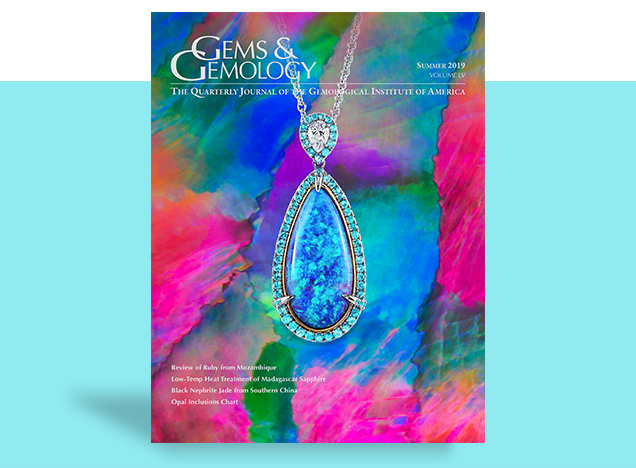Summer 2019 G&G: Mozambican Ruby, Challenges in Pearl Identification, and an Opal Inclusions Chart
August 15, 2019

The Summer 2019 edition of Gems & Gemology opens with a look at the past decade of ruby production in Mozambique, now the world’s leading supplier. The issue also features an investigation into low-temperature heat treatment of Madagascar sapphire, information on a source of black nephrite in southern China, a pair of pearl studies, and an opal inclusions chart.
A Decade of Ruby from Mozambique: A Review
While gemstones have been known from Mozambique for some time, the country became a major player in the trade after facet-quality ruby was unearthed in Niassa and, more importantly, Montepuez in 2009. In the lead article, Wim Vertriest and Sudarat Saeseaw provide a snapshot of the first decade of Mozambican ruby. The authors review production from the deposits, the characteristics of the rubies, and their impact on the market.
Madagascar Sapphire: Low-Temperature Heat Treatment Experiments
African corundum makes an encore in the second article. Known for its fine blue sapphire, Madagascar also produces specimens that react well to heat treatment at low temperatures to lighten their color. E. Billie Hughes and Rosey Perkins perform heating experiments to separate heated from unheated blue Madagascar sapphires.
Black Nephrite Jade form Guangxi, Southern China
A nephrite deposit in the southern Chinese region of Guangxi, discovered in 2012, has produced black nephrite jade that is popular in the Chinese market. A team of authors led by Qian Zhong study the gemological characteristics of 12 rough nephrite specimens from this locality and find that high iron content is responsible for their color and high refractive index. The authors assert that Guangxi’s nephrite deposits are part of a larger jade formation belt in southern China.
Evidence of Rotation in Flame-Structure Pearls from Bivalves of the Tridacnidae Family
Non-nacreous pearls with flame structures from the Tridacnidae family may exhibit some distinctive properties, including pseudo-chatoyancy as well as spirals and or/blade impeller patterns at the apex or base. Jean-Pierre Gauthier and coauthors examine 37 pearls from the Tridacnidae family to understand their properties and formation. The patterns seem to suggest rotation of the pearls during formation or during the growth phase prior to harvesting.
A Pearl Identification Challenge
Nicholas Sturman and a team from three different research institutes investigate the properties of two pearls that were anything but routine. The researchers were unable to positively identify the pearls’ origin (natural or cultured), their growth environment (freshwater or saltwater), or the producing mollusk.
Inclusions in Natural, Treated, Synthetic, and Imitation Opal
The issue also contains the fifth in G&G’s series of inclusion charts. Nathan Renfro and coauthors present a chart of micro-features in natural, treated, synthetic, and imitation opal.
Lab Notes
GIA laboratory staff members present their latest findings in the Lab Notes section, including a resin-coated and clarity-enhanced aquamarine pendant, a rough diamond coated with fake green “radiation stains,” and a report on a color-change spessartine garnet.
Micro-World
The Micro-World section, dedicated to the inner world of gemstones, features a purple fluorite inclusion in a Russian emerald, a Mexican opal with a large fluid inclusion, and an inclusion-rich black topaz from Utah.
Diamonds from the Deep
In G&G’s newest section, Karen Smit and Steven Shirey look at the relationship between kimberlites and diamonds and provides an understanding of how diamonds travel to the earth’s surface after formation in the mantle.
Gem News International
Finally, GNI correspondents from around the world report on jadeite jade from the Polar Ural Mountains of Russia, rubies from the Rock Creek deposit in Montana, and the leveraging the tagua nut as a sustainable alternative to ivory in jewelry.
Jennifer-Lynn Archuleta is the editor of Gems & Gemology.
.jpg)


